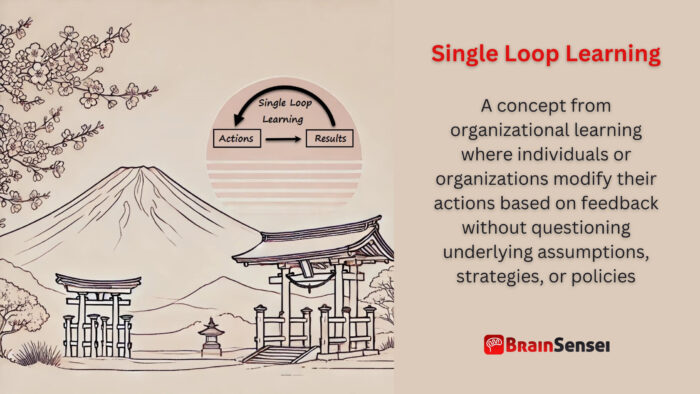
Single Loop Learning
What is Single Loop Learning?
Single loop learning is a concept from organizational learning in which individuals or organizations modify their actions based on feedback without questioning underlying assumptions, strategies, or policies. It focuses on detecting and correcting errors within a set framework rather than altering it. This approach is efficient for operational adjustments but may limit innovation and deeper problem-solving.
Key Takeaways
- Single loop learning corrects errors without questioning fundamental assumptions.
- It focuses on improving efficiency within existing policies or strategies.
- Common in structured, rule-based environments like corporate processes.
- Single loop learning contrasts with double loop learning, which challenges core assumptions.
- It is ideal for routine problem-solving but may hinder long-term adaptability.
Understanding Single Loop Learning
How It Works
In single loop learning, an organization or individual receives feedback, identifies a deviation, and adjusts actions to correct the issue while maintaining the current system. This cycle ensures efficiency and consistency but does not challenge the deeper reasons behind errors.
For example, if a company notices declining customer satisfaction, it might improve service response times (a correction) rather than examine whether its customer service policies are outdated.
Key Considerations
- Efficiency Over Innovation: Helps maintain stability but may limit more profound improvements.
- Error Correction: Focuses on fixing problems within set parameters.
- Rule-Based Approach: Works well in structured environments like manufacturing or finance.
- Potential Stagnation: This can lead to complacency if used exclusively.
Related Terms
- Double Loop Learning: Goes beyond error correction by questioning and altering existing assumptions and frameworks.
- Adaptive Learning: A broader concept that includes single and double loop learning for continuous improvement.
- Organizational Learning: A collective process where companies develop and retain knowledge for long-term growth.
- Feedback Loops: Systems for gathering and acting on feedback can be single or double loop.
- Operational Efficiency: A focus area where single loop learning is commonly applied to improve workflows.
Examples of Single Loop Learning in Different Industries
Manufacturing Industry
Maintaining efficiency and minimizing defects is critical to profitability and customer satisfaction in the manufacturing sector. A typical example of single loop learning occurs when a factory notices an increase in defective products coming off the production line. The immediate response is to add an extra quality check at the end of the assembly line. This correction ensures fewer defective products reach customers, but it does not address the root causes of the defects.
For instance, the real issue could be worn-out machinery, poorly trained staff, or suboptimal raw materials. However, instead of investigating these fundamental causes, management focuses on detecting and filtering out defects rather than preventing them. This quick-fix approach reduces the number of defective products temporarily but does not eliminate inefficiencies or long-term production challenges.
Over time, the factory may face higher operational costs due to the additional inspection processes, increasing the price per unit without improving the core manufacturing system. If the factory were to engage in double loop learning, it would examine the machinery, staff training programs, and material sourcing strategies more deeply to eliminate defects at the source. This approach would create a more sustainable and cost-effective solution rather than simply treating the symptoms of the problem.
Financial Services
Financial institutions rely heavily on efficiency and customer service to retain clients and maintain profitability. A bank experiencing slow loan processing times may respond by hiring additional staff to handle applications more quickly. While this reduces processing time in the short term, it does not address the underlying inefficiencies in the approval workflow.
The root cause of delays may be an outdated software system, redundant verification steps, or unclear policies that require unnecessary paperwork. By merely increasing the workforce, the bank is applying single loop learning—fixing the immediate issue without considering fundamental process improvements. Over time, this approach may lead to increased costs and complexity in operations without truly enhancing efficiency.
A more practical solution using double loop learning would be reevaluating the loan approval process. The bank could invest in automation, streamline verification steps, and improve digital documentation to reduce inefficiencies. Without such a deeper analysis, the organization risks continued inefficiencies despite the temporary fix of adding more personnel.
Healthcare Sector
Hospitals and healthcare organizations frequently encounter inefficiencies in patient care and operational workflows. A typical example of single loop learning in this sector is when a hospital notices an increase in patient wait times and responds by scheduling more doctors per shift. While this strategy may alleviate immediate congestion, it does not address the structural problems causing the delays.
For example, the real issue may be poor patient flow management, inefficient scheduling systems, or redundant paperwork slowing down admissions and discharges. The hospital misses an opportunity to redesign its processes for long-term efficiency by focusing only on increasing staffing levels. Moreover, adding more doctors may increase operational costs without improving service quality.
A double loop learning approach would involve rethinking patient intake procedures, leveraging digital health records for faster information retrieval, and optimizing appointment scheduling. By addressing the root causes of inefficiencies, the hospital could achieve lasting improvements in patient care rather than relying on short-term staffing solutions.
Retail Industry
Retailers frequently struggle with sales and customer engagement. Consider a large retail chain that notices declining sales and responds by increasing its advertising spending. While this may boost revenue in the short term, it does not address fundamental issues driving customers away.
The decline in sales could stem from factors such as outdated product offerings, poor in-store experiences, or increased competition from online retailers. By focusing solely on increasing marketing efforts, the company applies single loop learning—correcting the immediate issue without re-evaluating its business strategy.
Instead, a double loop learning approach would involve analyzing customer preferences, redesigning store layouts for a better shopping experience, or adopting a more potent e-commerce strategy to compete with online retailers. These fundamental changes could yield sustainable growth rather than relying solely on increased marketing expenses.
Automotive Industry
Automobile manufacturers must balance cost, quality, and innovation to remain competitive. Suppose a European car manufacturer experiences an increase in warranty claims due to mechanical failures. A single loop learning response would involve tightening quality control measures at the final inspection stage to catch defective vehicles before they reach customers.
Although this strategy temporarily reduces customer complaints, it fails to address the root cause of defects, which are supplier quality issues, outdated production techniques, or inadequate employee training. By focusing only on quality control at the final stage, the company risks higher rejection rates and wasted materials, increasing production costs.
A double loop learning approach would involve revisiting supplier relationships, improving manufacturing processes, and investing in employee training programs. Addressing these fundamental issues would reduce defects at the source rather than relying on additional inspections as a workaround.
IT Sector
Software companies frequently deal with customer complaints regarding usability, bugs, or slow response times. A typical example of single loop learning occurs when a software company sees an increase in customer complaints and responds by assigning more support staff to handle inquiries.
While this may improve customer satisfaction in the short term, it does not address the underlying causes of the complaints. These issues could include poor user interface design, inadequate software testing, or inefficient bug-fixing workflows. The company increases operational costs by merely adding support staff without fundamentally improving the product.
A double loop learning approach would involve reexamining software development practices, prioritizing user experience enhancements, and implementing more rigorous quality assurance testing. These steps would lead to a more robust product, reducing customer complaints at the source rather than just expanding support services.
Use Cases of Single Loop Learning Across Regions
North America (Retail Industry)
A large U.S. retail chain notices declining sales and decides to increase advertising rather than assess deeper issues like customer preferences and store layouts. While this strategy boosts revenue in the short term, it fails to address the underlying problem of shifting consumer behaviour toward online shopping. The company may continue to spend more on ads while customer loyalty diminishes.
Europe (Automotive Industry)
A European car manufacturer facing increased warranty claims adds final inspections instead of improving supplier relationships and production quality. They catch defective vehicles late rather than prevent them at the source, resulting in higher rejection rates and inefficiencies.
Asia (IT Sector)
A software company in India experiencing rising customer complaints expands its support team rather than improving software testing and UI design, increasing costs without resolving root issues. A better approach would be improving the product’s stability to reduce complaints rather than merely handling them more efficiently.
Single loop learning is a common approach across industries for addressing immediate problems without challenging underlying assumptions. While it helps maintain stability and short-term efficiency, it often leads to recurring issues and increased operational costs. Organizations that integrate double loop learning can improve sustainably by reevaluating their processes and strategies rather than just correcting surface-level problems.
Best Practices for Effective Single Loop Learning
Encourage Continuous Feedback Loops
Organizations should implement real-time feedback mechanisms to identify performance gaps and allow quick corrections. Regular feedback helps to fine-tune processes and improve efficiency.
Leverage Data-Driven Decision Making
Utilize analytics and performance metrics to inform decision-making. Data-driven insights help companies understand patterns, identify root causes of issues and make better-informed adjustments.
Balance Short-Term Fixes with Long-Term Strategy
While single loop learning is effective for immediate problem resolution, it should not be the sole approach. Organizations should periodically reassess their processes to ensure sustainable improvements.
Train Employees to Recognize Recurring Issues
Staff training programs should include problem-identification techniques to prevent recurring issues from being addressed only superficially.
Integrate Double Loop Learning When Necessary
While single loop learning corrects errors, organizations should also practice double loop learning to challenge assumptions and drive more profound improvements.
By following these best practices, organizations can maximize the benefits of single loop learning while minimizing its limitations, ensuring immediate efficiency and long-term success.
Single Loop Learning: Common Mistakes and Issues
Over-Reliance on Short-Term Fixes
Many organizations focus on immediate problem resolution without addressing the root causes, leading to recurring inefficiencies.
Lack of Critical Thinking
Employees and leaders may follow established procedures without questioning their effectiveness, preventing meaningful improvements.
Resistance to Change
Organizations that rely solely on single loop learning may struggle to adapt to industry shifts, leading to stagnation.
Failure to Incorporate Feedback
Ignoring valuable insights from customers or employees can result in continuous operational inefficiencies.
Increased Operational Costs
A superficial approach to problem-solving, neglecting core process revision, leads to budget inflation and resource waste.
Missed Opportunities for Innovation
Focusing only on immediate corrections discourages broader strategic thinking and innovation.
Organizations can refine their learning processes by understanding and mitigating these common mistakes , strivingfor operational efficiency and long-term sustainability.
Single Loop Learning: Frequently Asked Questions (FAQs)
How does single loop learning differ from double loop learning?
Single loop learning corrects errors within existing assumptions, while double loop learning questions and changes those assumptions.
Can single loop learning improve innovation?
Not significantly. It enhances efficiency but does not drive profound innovation since it does not challenge existing frameworks.
When is single loop learning most effective?
Single loop learning is most effective in structured environments with clear rules, such as compliance, quality control, and operational processes.
What industries benefit the most from single loop learning?
Manufacturing, finance, and healthcare, where consistent performance and adherence to standards are critical.
How can organizations balance single and double loop learning?
Organizations can balance single and double loop learning by integrating continuous improvement practices, regularly questioning strategies, and fostering a culture of deeper inquiry.
Additional Resources
- Single vs. Double-Loop Learning: Definitions and Differences
- Single-Loop Learning and Double-Loop Learning from projects
- Single vs. Double Loop Learning: A 2-Minute Introduction
Preparing for a PMI certification?
- Exam Prep Courses: PMP®, CAPM®, and PMI-ACP®
- Exam Simulators: PMP®, CAPM®, PMI-ACP®, PMI-PBA®, PMI-RMP®, PMI-SP®, PgMP®, and PfMP®
- Professional Development Units (PDUs): 15, 30, and 60 PDU Bundles



